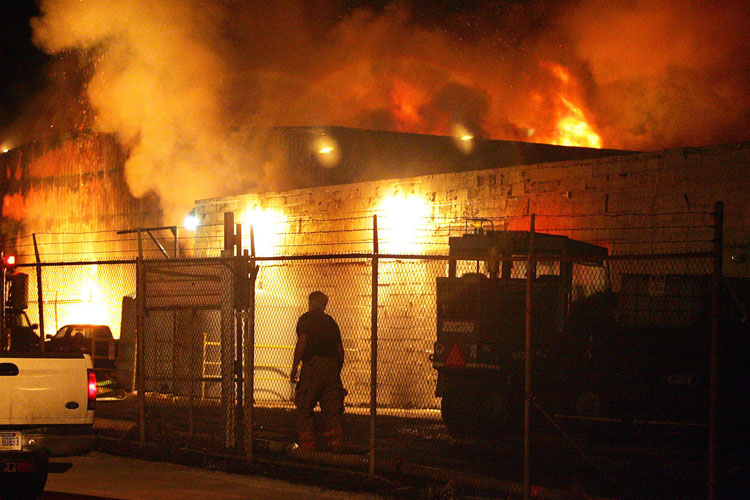When most people think of controlling dust in the workplace, they think of taking steps to avoid inhaling dusts to prevent health problems. However, the accumulation of combustible dusts in the workplace can lead to far greater consequences. As seen in recent years, neglect of housekeeping and improper handling of combustible dusts can lead to property damage, injuries and loss of life.
Any combustible material can burn rapidly when in a finely divided form. If such a dust is suspended in air in the right concentration, under certain conditions, it can become explosive. Even materials that do not burn in larger pieces (such as aluminum or iron), given the proper conditions, can be explosible in dust form.
The force from such an explosion can cause employee deaths, injuries, and destruction of entire buildings. For example, 3 workers were killed in a 2010 titanium dust explosion in West Virginia, and 14 workers were killed in a 2008 sugar dust explosion in Georgia. The U.S. Chemical Safety and Hazard Investigation Board (CSB) identified 281 combustible dust incidents between 1980 and 2005 that led to the deaths of 119 workers, injured 718, and extensively damaged numerous industrial facilities.
A wide variety of materials that can be explosive in dust form exist in many industries. Examples of these materials include: food (e.g., candy, sugar, spice, starch, flour, feed), grain, tobacco, plastics, wood, paper, pulp, rubber, pesticides, pharmaceuticals, dyes, coal, metals (e.g., aluminum, chromium, iron, magnesium, and zinc). These materials are used in a wide range of industries and processes, such as agriculture, chemical manufacturing, pharmaceutical production, furniture, textiles, fossil fuel power generation, recycling operations, and and metal working and processing which includes additive manufacturing and 3D printing.
OSHA estimates that 30,000 U.S. facilities are at risk for a major combustible dust explosion – across all industries. So, the threat of an industrial explosion in your facility is very real. But there are steps you can take right now to protect your people and your facility from combustible dust. If you can eliminate the dust, you can eliminate the explosion hazard. That’s why OSHA recommends – and in some cases requires – manufacturers to use certified explosion-proof vacuums as part of a regular plant maintenance program when collecting hazardous classed dust.
The National Fire Protection Association (NFPA) defines a combustible dust
as “a combustible particulate solid that presents a fire or deflagration hazard when suspended in air or some other oxidizing medium over a range of concentrations, regardless of particle size or shape.”
In general, combustible particulates having an effective diameter of 420 μm or smaller, as determined by passing through a U.S. No. 40 Standard Sieve, are generally considered to be combustible dusts. However, agglomerates of combustible materials that have lengths that are large compared to their diameter (and will not usually pass through a 420 μm sieve) can still pose a deflagration hazard. Therefore, any particle that has a surface area to volume ratio greater than that of a 420 μm diameter sphere should also be considered a combustible dust.
The vast majority of natural and synthetic organic materials, as well as some metals, can form combustible dust. The NFPA’s Industrial Fire Hazards Handbook states, “Any industrial process that reduces a combustible material and some normally non-combustible materials to a finely divided state presents a potential for a serious fire or explosion.”
Combustible/Conductive* dusts
- Class II Group E* metal dusts (Aluminum, Bronze, Chromium, Iron Carbonyl, Magnesium, Tantalum, Titanium, Zinc, Zirconium, and other commercial alloys)
- Class II Group F Carbonaceous dusts (Carbon black, Charcoal, coke, coal, etc.)
- Class II Group G combustible dusts ( Agricultural, Calcium, Chemical, Cocoa, Coffee, Corn, Cotton, Egg white, Epoxy resin, Flour, Grain, Lactose, Malt, Melamine, Milk, Oat, Plastic, Rice, Sodium, Spices, Starch, Sugars, Sulfur, Tobacco, Vinyl, Wheat, Whey, Wood, etc.)
- Pyrotechnics
- Ammunitions
- Explosives
- Glowing media
Suggested Industrial Vacuums for Recovery of Toxic & Combustible Dust
PrestiVac HEPAPlus* Vacuums are specifically designed to safely vacuum toxic dusts. Equipped with a Certified Absolute HEPAPlus*filter with an efficiency of 99.995% on 0.2 micron so there is no risk of exposure or contamination for the operator or the environment. These vacuums are tested for absolute filtration. Testing Method: IEST RP-CC034.3. H14. MIL-STD 282 / A.S.T.M. - D2986-91. MPPS method EN 1822.
PrestiVac Explosion Proof/Dust Ignition Protected Vacuums are designed to safely vacuum explosive, flammable, combustible conductive* dusts. Our Explosion Proof/Dust Ignition Protected Vacuums are completely grounded and static dissipating because they are built entirely with non-sparking metals and do not have any painted components so there is no risk of fire or explosion from a spark or static build up. All the electrical components, including the motor and starter are totally enclosed so there is no source of ignition. Our explosion proof vacuum cleaners comply with NFPA 484 guidelines and are an effective tool for good housekeeping practise as per OSHA.
- Dust Ignition Protected Division 2 Vacuums
- Dustless Sanding Vacuums
- Explosion Proof Division 1 Vacuums
- HEPA Vacuums
- Immersion Separator
- Immersion Separator Dustless Sanding Vacuums
Which Industries are at Risk with Combustible Dust?
- 3D Printing
- Aerospace / Aviation
- Agriculture
- Ammunitions
- Automotive / Body Shop
- Biological / Biotechnologies
- Chemicals
- Cleanrooms
- Coal
- Cosmetic
- Electronics
- Environment
- Energy & Natural Resources
- Fertilizer
- Firing / shooting Ranges
- Foundries
- Food Processing
- Healthcare
- Laboratories
- Manufacturing
- Metals
- Military / Defense
- Mining
- Packaging
- Pharmaceutical
- Polymers / Plastics
- Power
- Pulp & Paper
- Pyrotechnical
- Recycling
- Shipyards / Dockyards
- Telecommunications
- Textile
- Tobacco
- Waste













